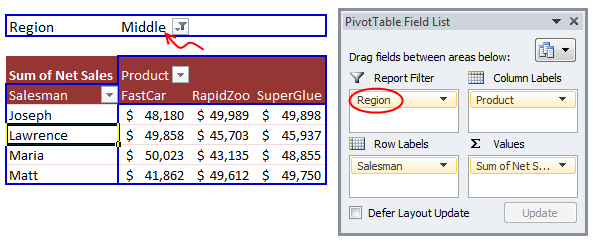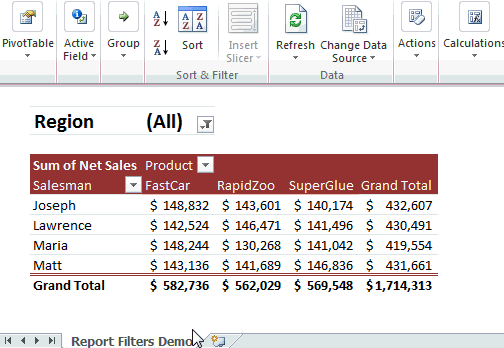 Today we will learn about Pivot Table Report Filters.
Today we will learn about Pivot Table Report Filters.
We all know that Pivot Tables help us analyze and report massive amount of data in little time. Excel has several useful pivot table features to help us make all sorts of reports and charts.
Report Filters are one such thing.
How do Report Filters help you?
Let us say, you are an analyst at ACME Inc., that has 3 products – Fastcar, Rapidzoo and Superglue. You have 4 salespersons – Joseph, Lawrence, Maria & Matt. You operate in 3 regions – West, North and Middle.
Now, you are given the data for all sales from Jan 2007 to July 2009 and your boss asks you, “I need a report on sales by product and salesperson in each region”.
This is where a Report filter would help you.
You can put Salesperson in Row label area, Product in Column area, net sales in value field area and region in report filter area of the pivot table. Then, you get a report like this:

You can immediately switch the report filter to other regions (or a combination of them) to produce the region-wise reports.
Generating Multiple Reports from One Pivot Table:
Using Report Filters, we can quickly generate multiple pivot reports. For this,
1) Click anywhere inside pivot table, and go to Options ribbon.
2) From here, click on little down arrow next to options, choose “Show Report Filter Pages”.
3) Select the filter field for which you want multiple pages.
4) Done! Excel produces multiple worksheets, one each for a report filter setting.
See this demo:

Few more tips on using Report Filters
Add Multiple Report Filters
You can add more than one report filter to a pivot table. This is a very useful way to slice and dice your data when you have lots of columns (dimensions). For eg., you could add report filters on Month, Region & Product.
Show Report Filters in rows or columns
From Pivot Table Options, you can set how Excel should layout the report filters. This setting is available in Layout & Format Tab.
 Select More than one value for Report Filter
Select More than one value for Report Filter
By default, Excel allows you to specify only one value per filter. But you can over-ride this by using the “Select multiple items” check-box in report filter.
Download Report Filters Demo Workbook
I have made a demo workbook showing how you can generate multiple reports from same pivot table. Go ahead and download the workbook.
Click here to download Report Filter Demo Workbook.
How do you use Report Filters
I often use Report filters to generate reports for a specific time-window or product group for my small business. I generally do this while analyzing sales or something. For eg. I would make a pivot chart with sales data and add a trend-line to it. Then I would change the report filter to instantly understand the trend for a different product. I like the power report filters give me in situations like this.
What about you? Have you used Report Filters before? In what situations do you find report filters help-ful. Please share your experience & tips using comments.
More Articles on Pivot Tables
If you would like learn more about Pivot Tables, go thru these articles:

















21 Responses to “How to Filter Odd or Even Rows only? [Quick Tips]”
Infact, instead of using =ISEVEN(B3), how about to use =ISEVEN(ROW())
So it takes away any chance of wrong referencing.
I like Daily Dose of Excel
I like it.
Just a heads up, you do need to have the Analysis ToolPak add-in activated to use the ISEVEN / ISODD functions. An alternative to ISEVEN would be:
=MOD(ROW(),2)=0
rather than use a formula, couldn't you enter "true" in first cell and "false" in the second and drag it down and than filter on true or false.
Just for clarification, is Ashish looking to filter by even or odd Characters or rows?
so many functions to learn!
Nice support by chandoo and team as a helpdesk. Give us more to learn and make us awesome. Always be helpful.......
In case you want to delete instead of filter,
IF your data is in Sheet1 column A
Put this in Sheet2 column A and drag down
=OFFSET(Sheet1!A$1,(ROWS($1:1)-1)*2,,)
(This is to delete even rows)
To delete odd rows :
=OFFSET(Sheet1!A$2,(ROWS($1:1)-1)*2,,)
If your numbered cells did not correspond to rows, the answer would be even simpler:
=MOD([cell address],2), then filter by 0 to see evens or 1 to see odds.
I sometimes do this using an even simpler method. I add a new column called "Sign" and put the value of 1 in the first row, say cell C2 if C1 contains the header. Then in C3 I put the formula =-1 * C2, which I copy and paste into the rest of the rows (so C4 has =-1 * C3 and so forth). Now I can just apply a filter and pick either +1 or -1 to see half the rows.
Another way, which works if I want three possibilities: in C2 I put the value 1, in C3 I put the value 2, in C4 I put the value 3, then in C5 I put the formula =C2 then I copy C5 and paste into all the remaining rows (so C6 gets =C3, C7 gets =C4, etc.). Now I can apply a filter and pick the value 1, 2, or 3 to see a third of the rows.
Extending this approach to more than 3 cases is left as an exercise for the reader.
Another way =MOD(ROW();2). In this case, must to choose betwen 1 and 0.
[...] How to Filter Even or Odd rows only [...]
very different style Odd or Even Rows very easy way to visit this site
http://www.handycss.com/tips/odd-or-even-rows/
Thanks for the tip, it worked like magic, saved having to delete row by row in my database.
Thanks!
Thankssssssssssssssss
Hi Chandoo- First of all thanks for the trick. It helped me a lot. Here I have one more challenge. Having filtered the data based on odd. I want to paste data in another sheet adjacent to it. How can I do that?
For Example-
A 1 odd
B 3 odd
C 4 even
D 6 even
I have fileted the above data for odd and want to copy the "This is odd number" text in adjacent/next sheet here. How can I do that. After doing this my data should look like this
A 1 odd This is odd number
B 3 odd This is odd number
C 4 even
D 6 even
Hi! Could you please help me find a formula to filter by language?
Thank you!
Chandoo SIR,
I HAVE A DATA IN EXCEL ROWS LIKE BELOW IS THERE ANY FORMULA OR A WAY WHERE I CAN INSTRUCT I CAN MAKE CHANGES , MEANS I WANT TO WRITE ONLY , THE FIG IS FRESH, BUT IN BELOW ROW IT WILL AUTOMATICALLY TAKE THE SOME WORDS FROM FIGS AND MAKE IN PLURAL FORM , WHILE USING '' ARE'' LIKE BELOW
The fig is fresh - row 1
Figs are fresh - row 2
The Pomegranate is red - row 3
Pomegranates are red - row 4
=IF(EVEN(A1)=A1,"EVEN - do something","ODD - do something else") with iferron (for blank Cell)